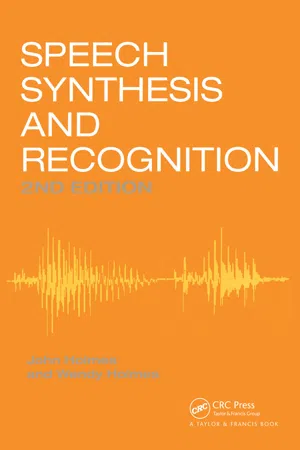Languages & Linguistics
Phone
A phone is a communication device that allows users to make and receive calls, send text messages, and access the internet. It is an essential tool for language and linguistic studies as it facilitates communication and language learning. The evolution of phones has also influenced language use and communication patterns in various linguistic communities.
Written by Perlego with AI-assistance
Related key terms
Related key terms
1 of 4
Related key terms
1 of 3
6 Key excerpts on "Phone"
- eBook - ePub
- Bruce M. Rowe, Diane P. Levine(Authors)
- 2022(Publication Date)
- Routledge(Publisher)
Phonology is the study of the sound system of a language, that is, what sounds are in a language and what the rules are for combining those sounds into larger units. Phonology can also refer to the study of the sound systems of all languages, including universal rules of sound.The Phoneme and the concept of significant differences in sounds
Any sound used in speech can be called a Phone or Phonetic unit or segment. A Phone is a unit of sound that can be mentally distinguished from other sounds in what is actually the continuous flow of sound that makes up speech. A Phone can be described based on its articulatory, auditory, and acoustic characteristics. For example, [ph ] is a Phone that can be said to be a bilabial, a stop, and a consonant, and it is oral and aspirated. A somewhat different type of unit, called a Phoneme, is the major unit of phonology.A Phone or Phonetic unit or segment is an actual speech sound produced by the vocal tract that is perceived as an individual and unique sound, different from other such sounds.The Phoneme is a more abstract unit than the Phone. The Phoneme is a mental construct rather than a physical unit. For instance, we have seen that the p sound can be unaspirated [p] or aspirated [ph ]. The [p] and [ph ] are physically two different sounds (Phones) that are produced in different ways. We can tell this because a thin piece of paper held in front of the lips moves when the aspirated p sound is made as in [p h ɪt] but does not move for the unaspirated p as in [spɪt]. Yet even if we aspirated the p in spit or did not aspirate the p in pit, we would still recognize the same words. The words might sound a little different than expected, but the meaning of each word would not change. In English, there is a grammatical rule that subconsciously directs a native speaker to aspirate the p sound when it is the first sound in a word or begins a stressed syllable and not to aspirate when it is not the first sound or the beginning of a stressed syllable. In other words, which p sound a native speaker of English uses is predictable because there is a rule governing its use; [p] and [ph - eBook - ePub
Experimental Psycholinguistics (PLE: Psycholinguistics)
An Introduction
- Sam Glucksberg, Joseph H. Danks(Authors)
- 2013(Publication Date)
- Psychology Press(Publisher)
spin, it sounds very much like a Russian speaker speaking English. In English, words are not differentiated by the presence or absence of aspiration on the Phoneme /p/, so whether we pronounce that /p/ sound with or without aspiration makes no difference in our interpretation of the word. In some other languages, such as Hindi, aspiration does yield meaningful differences.These examples show that a Phoneme is not a single speech sound, but a category of sounds that are treated as functionally identical. The single, individual sounds of a language are called PhoneS . Any given Phoneme consists of a set of Phones that are treated as identical, and often even heard as identical. For example, the English Phoneme /k/ is a category of sounds that includes, among others, the two Phones [k] and [q].2 The English Phoneme /p/ is a category of sounds that includes both the aspirated and unaspirated [p] Phones. The set of Phones categorized as a single Phoneme are called ALLOPhoneS of that Phoneme. The Phones [k] and [q] are two alloPhones of the English Phoneme /k/. This categorization becomes so automatic that we may never really hear the differences among the alloPhones.This automatic categorization is one of the reasons why we often find it difficult to learn a foreign language. If you were learning Arabic, one of the things you would have to learn is to hear the difference between [k] and [q]. You would also have to learn when to pronounce one and not the other, since, if you get them mixed up, you would not be saying the word you meant to say. A set of phonological problems is inherent in each language for speakers of other languages because each language has its own unique sound system. What is the nature of this sound system?English Phones and PhonemesThe Phones and Phonemes of a language can be organized into a reasonably coherent system in at least two ways. One basis for defining and organizing sounds is the ACOUSTIC properties of the sounds themselves, where the acoustic properties refer to the measurable properties of the sound waves involved. A second basis for dealing with speech sounds is their ARTICULATORY - eBook - ePub
Language, Culture, and Society
An Introduction to Linguistic Anthropology
- James Stanlaw, Nobuko Adachi, Zdenek Salzmann(Authors)
- 2018(Publication Date)
- Routledge(Publisher)
For example, each vowel is characterized by several resonance bands, referred to as formants, which represent the overtone structure of a vowel produced by the shape of the vocal tract. Because the position of the tongue changes with the production of different vowels, the formants vary correspondingly. Finally, auditory Phonetics is the study of how speech sounds are perceived and interpreted by the various organs of the human body (ear, auditory nerves, and brain). We will focus on articulatory Phonetics here, leaving the other two areas to physicists, neurologists, speech therapists, and other specialists. FROM PhoneS TO PhoneMES Phones: The Smallest Unit of Sound The smallest perceptible discrete segment of speech is a Phone, a speech sound considered a physical event. A succession of Phones in a particular language makes up a stretch of speech, or an utterance. Each utterance is unique, occurring if not under different circumstances at least at a different time. Yet people do not respond to each instance of speech as though it were different from all others. Such utterances as “Where have you been?” or “I have no time just now” are treated as if they were much the same every time they are said, regardless of whether the voice belongs to a woman, man, or child, or happens to be clear or hoarse. Because there is so much likeness in what is objectively different, it is possible to represent speech sounds—Phones—through the written symbols of a suitable Phonetic alphabet. Linguistic anthropologists make Phonetic transcriptions of words or utterances whenever they wish to obtain a sample of speech for subsequent analysis. Table 3.4 CHART OF THE MOST IMPORTANT MANNERS OF ARTICULATION (VERTICAL AXIS) AND POINTS OF ARTICULATION (HORIZONTAL AXIS) OF SELECTED CONSONANTS Note: white cells = Phonemes used in English; dark gray cells = sounds common in English but not Phonemic; light gray cells = not in English TABLE 3.5 THE CONSONANT PhoneMES IN AMERICAN - eBook - ePub
- Ali Almanna, Juliane House(Authors)
- 2023(Publication Date)
- Routledge(Publisher)
2 Phonetics and phonologyDOI: 10.4324/9781003228028-3This chapter is an introduction to Phonetics, phonology, and the main differences between them. It also familiarizes you with the main branches of Phonetics, such as ‘articulatory Phonetics’, ‘acoustic Phonetics’, and ‘auditory Phonetics’. Further, the main stages of sound production, such as ‘respiration’, ‘phonation’, ‘oro-nasal process’, and ‘articulation’ are explained in this chapter. Added to this, phonological features are discussed in a direct link to translation.After studying this chapter, you should be able to (1) define Phones, Phonemes, and alloPhones; (2) identify vowel and consonant sounds in English; (3) identify the place of articulation and manner of articulation; (4) describe voiced and voiceless consonants; (5) distinguish simple vowels from diphthongs; and (6) assess the phonological features that should be reflected while translating between languages.What is the difference between ‘Phonetics’ and ‘phonology’?Phonetics and phonology (from the word ‘Phone’, meaning ‘sound’) are the branches of linguistics that study sounds but from different perspectives (for more details, see Ladefoged and Johnson 2010 ). While phonology focuses on how sounds function in relation to each other in a certain language, Phonetics concentrates on how sounds are produced by speakers’ vocal apparatus, transmitted by atmospheric air, and perceived by listeners’ auditory system. It thus provides “methods for their description, classification, and transcription” (Crystal 1980/2008 - eBook - ePub
- Wendy Holmes(Author)
- 2002(Publication Date)
- CRC Press(Publisher)
Figure 1.1 Illustration of the processes involved in communicating ideas by speech. It is not easy to separate the concepts in the brain from their representation in the form of language.1.6 PhoneMES, PhoneS AND ALLOPhoneSMany of the distinctions that can be made in a narrow Phonetic transcription, for example between different people pronouncing the same word in slightly different ways, will have no effect on meaning. For dealing with the power of speech sounds to make distinctions of meaning it has been found useful in phonology to define the Phoneme, which is the smallest unit in speech where substitution of one unit for another might make a distinction of meaning. For example, in English the words “do” and “to” differ in the initial Phoneme, and “dole” and “doll” differ in the middle (i.e. the vowel sound). There may be many different features of the sound pattern that contribute to the Phonemic distinction: in the latter example, although the tongue position during the vowel would normally be slightly different, the most salient feature in choosing between the two words would probably be vowel duration. A similar inventory of symbols is used for Phonemic notation as for the more detailed Phonetic transcription, although the set of Phonemes is specific to the language being described. For any one language only a small subset of the IPA symbols is used to represent the Phonemes, and each symbol will normally encompass a fair range of Phonetic variation. This variation means that there will be many slightly different sounds which all represent manifestations of the same Phoneme, and these are known as alloPhones.Phonologists can differ in how they analyse speech into Phoneme sequences, especially for vowel sounds. Some economize on symbols by representing the long vowels in English as Phoneme pairs, whereas they regard short vowels as single Phonemes. Others regard long and short vowels as different single Phonemes, and so need more symbols. The latter analysis is useful for acknowledging the difference in Phonetic quality between long vowels and their nearest short counterparts, and will be adopted throughout this book. We will use the symbol set that is most widely used by the current generation of British Phoneticians, as found in Wells (2000) for example. With this analysis there are about 44 Phonemes in English. The precise number and the choice of symbols depends on the type of English being described (i.e. some types of English do not make Phonetic distinctions between pairs of words that are clearly distinct in others). It is usual to write Phoneme symbols between oblique lines, e.g. /t/, but to use square brackets round the symbols when they represent a particular alloPhone, e.g. [t]. Sometimes the word Phone - eBook - ePub
Applying Linguistics in the Classroom
A Sociocultural Approach
- Aria Razfar, Joseph C. Rumenapp(Authors)
- 2013(Publication Date)
- Routledge(Publisher)
3 Phonology Why Languages Sound Different to Second Language Learners Learning Goals- Summarize the basic concepts of phonology.
- Understand potential challenges in learning English.
- Perform basic contrastive analysis.
- Use phonological analysis to inform teaching practices.
- Understand the different types of alphabets and spelling conventions.
- Use a Phonemic chart to design language learning activities.
- Create a case study to analyze a particular topic in phonology.
KEY TERMS/IDEAS: alloPhone, alphabet, contrastive analysis, grapheme, logographic/pictographic orthography, orthography, Phoneme, Phonemic awareness, Phone, phonology, minimal pairsIn the previous chapter, we learned about the inventory of sounds used in human speech. In this chapter, we will turn our attention toward how those sounds are organized in language. Traditionally, phonology is the study of how speech sounds are structured based on rules in a given language. Linguists have long pointed to these phonological rules to explain many of the differences between human languages. They look at the form or structure of a language to further explain how language is ordered in the human mind. From this perspective, phonology affords a useful analysis to break down language into its smallest units, the sounds that a speaker recognizes.Of course, for our purposes here, we are not so much concerned about the structure and form of a language for a descriptive analysis, but rather to give us insight into how we can understand our language-learning students in a classroom context. Therefore, in this chapter, we will focus on how phonological analysis can inform our understanding of reading, learning a second language, and identity. We will briefly introduce how to study the phonology of a language. Then we will discuss how to use that analysis in understanding alphabetic systems and reading English, specifically. After learning how knowledge of phonology can be used in classroom language learning, we will look at how the phonology of a language is used as an identity marker which is often the basis for stigmatization. Finally, we will provide case studies of teachers who used phonological analysis to address specific issues of language learners they identified.
Index pages curate the most relevant extracts from our library of academic textbooks. They’ve been created using an in-house natural language model (NLM), each adding context and meaning to key research topics.
Explore more topic indexes
Explore more topic indexes
1 of 6
Explore more topic indexes
1 of 4





